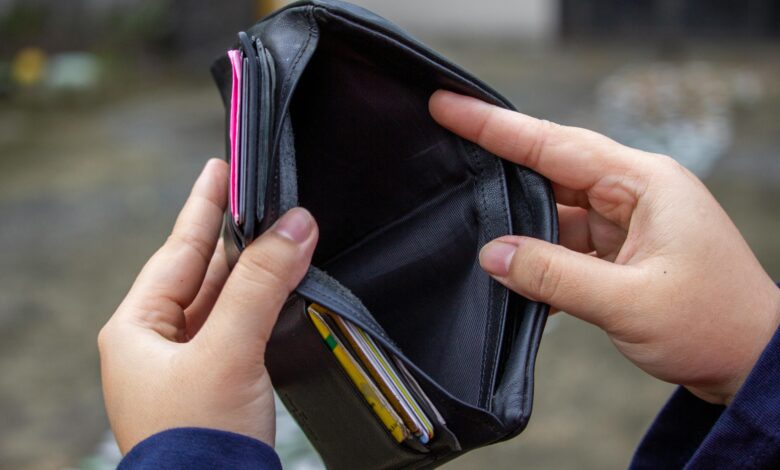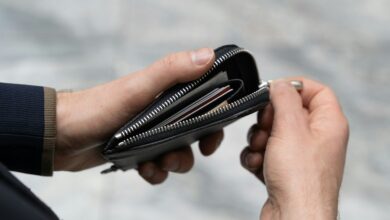10 Bad Spending Habits You Need To Break ASAP

Let me guess, you opened your banking app this morning and wondered where your paycheck disappeared to.
Again. You’re not alone, friend. Most of us are bleeding money through habits we don’t even realize we have.
I spent years watching my bank account drain like someone pulled the plug, and honestly?
I was the one holding the plug. As someone with a master’s in financial management, I’ve seen thousands of people make the same mistakes I did.
The crazy part? These habits feel completely normal until you actually stop and examine them.
Here’s the thing: your spending habits are either building your wealth or destroying it.
There’s no middle ground. Ready to figure out which camp you’re in?
Let’s talk about the money traps that are probably eating your paycheck right now.
What Are Bad Spending Habits?
Think of bad spending habits as those sneaky financial decisions that seem harmless in the moment but compound into serious damage over time.
We’re talking about consistently choosing the $8 latte over brewing coffee at home or upgrading your phone every year when your current one works perfectly fine.
Here’s a real example: Picture someone earning $50,000 annually who insists on leasing a luxury car for $600 monthly.
Meanwhile, they could drive a reliable used vehicle with a $300 monthly payment.
That’s $3,600 yearly just… gone. For what? A fancier logo on the steering wheel?
The financial psychology behind this is fascinating. These habits develop because we prioritise immediate gratification over long-term stability.
Your brain literally lights up when you make impulse purchases; it’s the same dopamine hit you get from eating chocolate or scrolling social media.
Unfortunately, your bank account doesn’t share your brain’s enthusiasm.
Bad spending patterns typically fall into three categories: emotional spending (buying stuff when you’re stressed), status-driven spending (keeping up with your Instagram feed), and convenience spending (paying extra because you can’t be bothered). Sound familiar? Yeah, I thought so.
How Do I Stop Reckless Spending?
Alright, let’s get tactical. The foundation of controlling reckless spending is creating a budget that actually works for your life.
I’m not talking about some complicated spreadsheet that requires a finance degree to understand.
I mean a simple, functional plan that tells your money where to go instead of wondering where it went.
Start with the 50/30/20 rule as your baseline:
- 50% for needs (rent, utilities, groceries)
- 30% for wants (entertainment, dining out)
- 20% for savings and debt repayment
But here’s what nobody tells you: budgeting isn’t just about tracking numbers.
It’s about understanding your spending triggers. Do you shop when you’re bored? Stressed? Celebrating?
Once you identify your triggers, you can create guardrails.
I remember when I first got serious about my finances. I realised I was spending $400 monthly on food delivery. Four. Hundred. Dollars. On meals I could’ve cooked for $100.
The moment I tracked it, I felt physically sick. That awareness alone cut my delivery spending by 75% within a month.
Use tools like Mint or YNAB (You Need A Budget) to automate your tracking.
These apps connect to your accounts and categorise spending automatically.
No more pretending you spent $50 on groceries when it was actually another Amazon binge.
Why Do People Spend Recklessly?
Let’s get psychological for a second. Reckless spending rarely happens because people are stupid or careless. It happens because of deeper issues most folks never address.
The real culprits behind reckless spending:
Lack of financial education: Most schools don’t teach personal finance. We learn calculus, but not how to calculate compound interest on debt. Wild, right?
Emotional voids: Shopping becomes therapy. Bad day at work? Buy something. Relationship stress?
Buy something. The temporary high makes you feel better until the credit card bill arrives.
Social comparison: Your coworker bought a new car, your neighbour renovated their kitchen, your college friend is always posting vacation pics.
Suddenly, your perfectly fine life feels inadequate, so you spend to keep up.
Poor impulse control: This is the big one. We live in an era of one-click purchasing. Your brain doesn’t have time to process whether you actually need that thing before it’s already ordered.
Misaligned priorities: When you don’t have clear financial goals, every spending decision feels equally valid.
Want to retire early? That changes how you view buying another pair of shoes you’ll wear twice.
I’ve counselled clients who earned six figures but were broke, and others earning $40,000 who had healthy savings. The difference? Not income. Priorities and habits.
Why You Must Break Bad Spending Habits
Let me paint you a picture of two futures. In Future A, you continue your current spending patterns.
That daily $6 coffee? Over 30 years at 7% investment returns, that’s $122,000 you didn’t accumulate.
Those monthly subscriptions you forgot about? Another $50,000 gone.
Future B looks different. You break these habits, redirect that money intelligently, and build actual wealth.
Not Instagram fake wealth, real financial security that lets you sleep at night.
Here’s what bad spending habits cost you:
Debt accumulation: The average American carries $90,460 in debt. Credit cards, car loans, and personal loans all add up.
Once you’re in the debt trap, you’re working to pay interest instead of building wealth. Banks love this. You shouldn’t.
Zero emergency fund: 40% of Americans can’t cover a $400 emergency without borrowing.
That’s terrifying. When your car breaks down or you need dental work, you’re immediately in crisis mode.
All because everyday spending leaves nothing for the actual emergencies.
Destroyed credit score: Late payments and maxed-out cards tank your credit score.
Need to buy a house someday? Good luck getting a decent mortgage rate.
Your reckless spending today literally costs you tens of thousands in future interest.
Missed investment opportunities: Every dollar you waste on nonsense is a dollar that can’t work for you.
The stock market has historically returned about 10% annually.
Your impulse purchases? They return 0%. Actually, negative returns occur because they depreciate.
Retirement disaster: The magic of compound interest works both ways. Start saving early with good habits, and you’ll retire comfortably.
Start late because you spent your 20s and 30s living paycheck to paycheck, and you’re working until you’re 75. Your choice.
I’ve seen clients cry in my office when we run the numbers on their future retirement income based on current habits.
It’s a wake-up call nobody wants but everyone needs.
How To Control Your Spending Habits
Controlling your spending isn’t about becoming a financial monk who never enjoys life. It’s about intentionality.
Every dollar you spend should serve a purpose, whether that’s meeting a need, providing genuine joy, or advancing your goals.
Here’s my proven framework for taking control:
Do a spending autopsy: Pull your last three months of bank and credit card statements.
Categorise every transaction. This exercise sucks, but it’s essential.
You can’t fix what you don’t measure. When I did this, I discovered I was spending $150 monthly on apps I’d forgotten I subscribed to. Brutal.
Create spending rules: Establish personal policies. Mine include: no purchases over $100 without sleeping on it, no buying anything just because it’s on sale, and no food delivery more than twice monthly.
Your rules should address your specific weaknesses.
Implement the 24-hour rule: See something you want? Wait 24 hours. If you still want it tomorrow and it fits your budget, fine.
You’ll be shocked at how often tomorrow you realise yesterday you were being ridiculous.
Use cash for discretionary spending: Withdraw your weekly fun money in cash.
When it’s gone, it’s gone. The physical act of handing over cash creates psychological friction that swiping a card doesn’t. This technique alone reduces spending by 15-20% for most people.
Automate good decisions: Set up automatic transfers to savings and investment accounts right after payday.
You can’t spend what you never see. Pay yourself first, live on what’s left.
Find cheaper alternatives: Love restaurants? Learn to cook better at home. Enjoy movies? Get a streaming service instead of hitting theatres.
Want fancy coffee? Buy a good espresso machine. The upfront cost hurts, but the long-term savings are massive.
The goal isn’t deprivation. It’s optimisation. Spend on what genuinely matters, cut the stuff that doesn’t.
10 Bad Spending Habits You Need To Break Now
Time to get specific. These are the spending habits destroying budgets everywhere, including yours. Let’s break them down one by one.
1. Purchasing Cheap Or Inferior Products

Ever heard the phrase “buy once, cry once”? There’s financial wisdom buried in that saying.
Cheap stuff costs more in the long run, a lesson I learned the hard way with a $30 vacuum that died after three months.
Quality purchases seem expensive initially, but they’re investments. A $200 pair of work shoes that lasts five years beats five pairs of $60 shoes that each last a year.
The math is simple: $200 versus $300, plus the hassle of constantly replacing stuff.
Where quality matters most:
- Work tools and equipment you use daily
- Mattresses and bedding (you spend a third of your life sleeping)
- Shoes and winter coats
- Kitchen appliances you rely on
- Electronics like laptops and phones
Where cheap is fine:
- Trendy clothes you’ll wear once
- Home decor
- Basic kitchen utensils
- Phone cases and accessories
The key is understanding value versus price. Value considers lifespan, performance, and repair costs.
Price is just the upfront number. Stop being seduced by low prices when they deliver low value.
I now research major purchases obsessively. Reddit reviews, YouTube comparisons, professional assessments, I want to know I’m buying something that’ll last.
It’s boring but effective. My last winter coat cost $300 six years ago and still looks new.
My friend bought three $100 coats at that time. Who spent wisely?
2. Paying For Subscriptions You Don’t Use
Subscription creep is real, and it’s quietly draining your account. The average person has 12 subscriptions and forgets about 5 of them.
That’s roughly $80 monthly, nearly $1,000 yearly, on services you literally don’t use.
Think about it: Netflix, Spotify, gym membership, meal kit service, cloud storage, gaming subscriptions, software tools, beauty boxes… it adds up fast.
Each one feels small, but together they’re significant.
Conduct a subscription audit right now:
- List every subscription from your bank statements
- Cancel anything you haven’t used in 30 days
- Downgrade services you barely use
- Share subscriptions with family when possible
I use Truebill to track and cancel subscriptions. This app finds recurring charges and lets you cancel with one tap. Game-changer.
Here’s the thing: companies count on you forgetting. They make signing up easy and cancelling annoying.
That monthly charge is small enough to ignore but large enough to matter over time. Don’t fall for it.
Cut ruthlessly. If you haven’t used it in a month, you won’t miss it. I cancelled six subscriptions last year and literally never thought about them again. Saved $720.
3. Shopping For Status
Let’s talk about the most expensive habit of all: trying to impress people who don’t care about you with money you don’t have.
Status spending is a trap designed by marketers and enabled by social media.
You don’t need the newest iPhone when your current one works fine. You don’t need designer clothes to look good.
Also, you definitely don’t need a luxury car to prove you’ve “made it.”
Know what actually impresses financially savvy people? A healthy investment portfolio and zero debt.
The brutal truth about status purchases:
- Nobody cares as much as you think
- The dopamine hit lasts days, the payments last years
- Wealth isn’t about looking rich; it’s about being financially secure
- Rich people shop at Costco, too
I have a client worth $3 million who drives a 10-year-old Honda and wears Costco jeans.
I have another client earning $65,000 who leases a BMW and carries $30,000 in credit card debt. Guess which one sleeps better?
The hedonic treadmill is real. You buy something fancy, feel great for a week, then it becomes your new normal, and you need something fancier.
It never ends until you step off the treadmill entirely.
Want to know what actually builds confidence? Financial security.
The feeling of having six months of expenses in savings beats any designer handbag. Being debt-free is more impressive than any car.
4. Not Having A Budget

Flying blind financially is financial suicide. Period. I don’t care if you hate spreadsheets or think budgets are restrictive.
Without a budget, you’re hoping to succeed. With a budget, you’re planning to succeed. Big difference.
A budget isn’t about restriction; it’s about intention.
It’s a permission slip to spend guilt-free on what you’ve planned for, and a defence mechanism against everything else.
Budget methods that actually work:
Zero-based budgeting: Every dollar gets assigned a job before the month starts. Income minus expenses equals zero.
This is what I use personally. EveryDollar makes it easy.
Envelope system: Physical or digital envelopes for each spending category. When an envelope is empty, you’re done spending in that category. Brutal but effective.
Reverse budgeting: Pay savings and investments first, spend what’s left. Simple and surprisingly powerful.
50/30/20 budget: 50% needs, 30% wants, 20% savings. Great starting point for beginners.
Pick one method and commit for three months. That’s long enough to see results but short enough not to feel overwhelming.
Track everything. Every coffee, every parking fee, every random Amazon purchase.
The magic happens when you realise where your money is actually going versus where you think it goes. That awareness alone changes behaviour dramatically.
5. Spending More For Convenience
Convenience is expensive, and we’re addicted to it. Food delivery, drive-throughs, pre-cut vegetables, and last-minute shopping at expensive nearby stores all cost significantly more than the alternative.
The convenience trap looks like this: You’re tired after work, so you order delivery instead of cooking. That $35 dinner would’ve cost $8 to make at home.
Do this three times a week, and you’ve spent $4,212 annually on convenience. That’s nearly a month’s rent for some people.
Convenience costs you didn’t realise:
Food delivery fees: Delivery fees, service fees, tips, and inflated menu prices. A $15 meal becomes $30
Gas station purchases: Everything costs 30-50% more than at a grocery store
Last-minute shopping: Didn’t plan, now you’re paying premium prices at the closest store
Pre-made meals: Meal kits and pre-prepped ingredients cost 3x what cooking from scratch does
Look, I get it. Time is valuable. But are you really saving time, or are you just avoiding minor inconvenience?
Meal prepping on Sunday saves hours during the week. Keeping a stocked pantry prevents expensive last-minute runs.
I batch-cook on Sundays now. Three hours of work give me lunches and dinners for the week.
The initial effort feels like a lot, but I save 15+ hours and hundreds of dollars weekly. That’s a trade I’ll make every time.
Challenge yourself: What convenience purchases can you eliminate by adding 10 minutes of planning? The answer will shock you.
6. Taking A Sale Price At Face Value

Sales are psychological warfare, and retailers are winning. That “50% off” sign is designed to short-circuit your rational brain and trigger impulse purchases.
But here’s what they don’t tell you: the original price was often inflated to make the sale look good.
Plus, saving 50% on something you didn’t need isn’t savings, it’s spending. You didn’t save $50; you spent $50 on unnecessary stuff.
How to not get played by sales:
Research first: Know the typical price before assuming the sale is good. Use CamelCamelCamel for Amazon price history.
Calculate actual savings: Is this item cheaper than competitors right now? Check.
Ask the need question: Would you buy this at full price? If not, you probably don’t need it on sale either.
Beware “limited time” pressure: These sales run constantly. Scarcity is manufactured to push decisions.
Black Friday is the ultimate example. People camp outside stores for deals that are often matched online within weeks.
They buy TVs they don’t need because the price is “too good to pass up.” That’s not smart shopping, that’s marketing manipulation.
I now ignore sales entirely unless I was already planning to buy that item. My wallet thanks me.
The dopamine rush of “getting a deal” isn’t worth the actual cost.
7. Signing Up For Retail Newsletters
Those marketing emails are designed by people who studied consumer psychology to get your money. Every email is crafted to trigger FOMO, urgency, and desire.
They work, which is why retailers invest millions in email marketing.
Studies show people who subscribe to retail newsletters spend 138% more than non-subscribers.
Let that sink in. The “exclusive deals” cost you more than paying full price occasionally would.
The psychology behind retail emails:
Frequency creates familiarity: Daily emails keep brands top-of-mind
Exclusive deals trigger urgency: “Just for you” makes you feel special and rushed
Free shipping thresholds: Encourages adding more items to qualify
Abandoned cart reminders: Creates guilt and urgency to complete purchases
Unsubscribe from everything. Seriously, every retail newsletter. If you need something, you’ll remember to check.
The absence of constant sales notifications removes temptation entirely.
I unsubscribed from 47 retail newsletters two years ago. Know how often I’ve missed them? Never.
Know how much less I spend? About $200 monthly. FYI, that’s $2,400 annually on stuff I didn’t need and only bought because an email reminded me it existed.
Use Unroll.me to mass-unsubscribe if you’re drowning in promotional emails.
Takes five minutes, saves thousands.
8. Shopping for Groceries Without A List
Walking into a grocery store without a list is like going into battle without a plan. You’re going to lose, and it’s going to be expensive.
Grocery stores are designed to make you spend more. Product placement, lighting, music, smells, it’s all strategic.
Studies show shoppers without lists spend 20-30% more than planned. That’s $40-60 extra per $200 trip. Do that twice monthly, and you’re wasting $960-1,440 yearly.
The grocery store manipulation tactics:
Essential items in the back: Forces you to walk past everything else
Eye-level placement: Most expensive brands are at eye level, and cheaper options require bending
Impulse buys at checkout: Candy, magazines, drinks, when you’re committed to purchasing
Sample stations: Free taste creates reciprocity pressure to buy
Oversized carts: Make you feel like you haven’t bought enough
My grocery strategy is military-grade organised:
- Meal plan for the week
- Create a detailed shopping list organised by store layout
- Set a budget for the trip
- Shop alone (kids and partners increase spending)
- Never shop hungry (seriously, never)
- Stick to the list religiously
This approach cut my grocery spending by 35% without sacrificing quality or variety.
I buy what I need, use what I buy, and waste almost nothing. Revolutionary? No. Effective? Absolutely.
9. Falling Victim To The BOGO Trick
“Buy one, get one free” sounds like a deal, but it’s often a trap. You’re buying twice as much as you need, often of perishable items that’ll go bad.
Or you’re buying something you never needed in the first place just because “it’s free.”
Retailers aren’t stupid. They run BOGO deals on overstocked items or products near expiration.
They’re solving their inventory problem while making you think you’re winning.
Spoiler: they’re winning.
When BOGO makes sense:
- Non-perishable items you definitely use
- Products you’d buy anyway at full price
- Items you can split with family/friends
- Things with long shelf lives
When BOGO is a trap:
- Perishable food you can’t eat quickly enough
- Products you’ve never tried
- Items “on sale” that are still more expensive than alternatives
- Anything that creates clutter you don’t need
Real talk: Costco is full of BOGO psychology. That 30-pack of protein bars seems like a deal until you realise you hate them after bar number three.
Now you’ve got 27 bars you’ll force down out of guilt.
Calculate the per-unit price and compare.
Sometimes, two regular-priced items at a competitor are cheaper than the BOGO deal. Do the math, every time.
10. Using Multiple Credit Cards
Credit cards are financial tools that can build or destroy your wealth.
Using them responsibly with one card? Smart. Juggling multiple cards and carrying balances? Financial self-sabotage.
The credit card industry generates $120 billion annually in interest and fees from people who can’t manage their cards properly.
Don’t contribute to that statistic. The house always wins when you play their game.
Why multiple credit cards destroy finances:
Harder to track spending: Money moves across cards, making it impossible to see the full picture
Interest compounds across accounts: Each card charges interest independently, multiplying costs
Minimum payments are traps: Paying minimums means decades of debt and thousands in interest
Increased temptation: More available credit means more opportunity to overspend
Credit utilisation issues: High balances across multiple cards tank your credit score
I advocate for one cash-back credit card that you pay off in full monthly, or no credit cards at all. If you can’t trust yourself with credit (no judgment, many can’t), use debit exclusively.
My personal rule: If I can’t afford to buy it with cash today, I can’t afford to put it on credit.
The credit card is for cash-back rewards and fraud protection, not for buying stuff I can’t afford.
If you’re carrying balances on multiple cards, stop using them immediately.
Focus on paying them off using either the debt avalanche method (highest interest first) or the debt snowball method (smallest balance first).
Check out Debt.org for strategies and calculators.
Final Thoughts
Look, breaking bad spending habits isn’t going to happen overnight. You built these patterns over years, maybe decades.
Expecting to flip a switch and suddenly become financially perfect is unrealistic and sets you up for failure.
What you can do is commit to improving 1% at a time. Pick one habit from this list and focus on changing it this month. Just one. Master it, then move to the next.
Small, consistent changes compound into massive results over time.
The path to financial stability isn’t sexy. It’s not about getting rich quickly or finding some secret investment strategy.
It’s about controlling the stuff you can control, your spending habits. Do that consistently, and the wealth follows naturally.
Your future self is either going to thank you or curse you based on the decisions you make today. Choose wisely.
Ready to take control? Start with that spending audit. The truth might hurt, but it’s the wake-up call you need. 🙂








